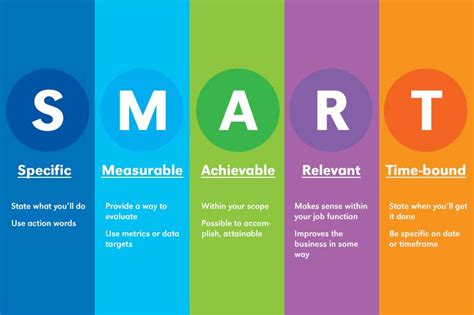Crafting Smart Goals: 5 Steps With Examples

Setting goals is an essential part of achieving success. However, setting vague or unrealistic goals can be demotivating and counterproductive. That’s where SMART goals come in. SMART is an acronym that stands for Specific, Measurable, Achievable, Relevant, and Time-bound. By following these five steps, you can craft SMART goals that will help you achieve your desired outcome.
Step 1: Be Specific
The first step in crafting a SMART goal is to be specific. This means defining exactly what you want to achieve. For example, instead of setting a goal to “lose weight,” a specific goal would be to “lose 10 pounds in the next 3 months.”
Example:
John wants to increase his sales this quarter. Instead of setting a vague goal to “increase sales,” he sets a specific goal to “increase sales by 15% in the next quarter.”
Step 2: Make It Measurable
The second step is to make your goal measurable. This means defining a way to track your progress and determine when you have achieved your goal. For example, if your goal is to “improve customer satisfaction,” you could measure this by tracking customer feedback surveys.
Example:
Jane wants to improve her public speaking skills. Instead of setting a vague goal to “improve public speaking,” she sets a measurable goal to “complete a public speaking course and give a successful presentation to an audience of 50 or more.”
Step 3: Ensure It’s Achievable
The third step is to ensure your goal is achievable. This means setting a goal that is challenging but realistic. Setting a goal that is too difficult or impossible to achieve can be demotivating.
Example:
Mike wants to start his own business. Instead of setting an unrealistic goal to “become a millionaire in the first year,” he sets an achievable goal to “earn $50,000 in revenue in the first year of business.”
Step 4: Make It Relevant
The fourth step is to make your goal relevant. This means setting a goal that is aligned with your values, interests, and long-term objectives. Setting a goal that is not relevant to your life can be demotivating and lead to failure.
Example:
Sarah wants to learn a new language. Instead of setting a goal to “learn any language,” she sets a relevant goal to “learn Spanish to be able to communicate with her Spanish-speaking co-workers.”
Step 5: Set a Time-bound Deadline
The fifth and final step is to set a deadline for achieving your goal. This means defining a specific date or time frame for when you want to achieve your goal. Setting a deadline helps create a sense of urgency and motivation to achieve your goal.
Example:
Tom wants to save money for a down payment on a house. Instead of setting a goal to “save money for a house,” he sets a time-bound goal to “save $20,000 for a down payment on a house within the next 2 years.”
Conclusion
By following these 5 steps, you can craft SMART goals that will help you achieve your desired outcome. Remember to be specific, measurable, achievable, relevant, and time-bound. Setting SMART goals can help you stay focused, motivated, and on track to achieving your goals.
FAQs
What are SMART goals?
SMART goals are goals that are Specific, Measurable, Achievable, Relevant, and Time-bound. By following these five criteria, you can create goals that are clear, achievable, and motivating.
Why are SMART goals important?
SMART goals help you stay focused, motivated, and on track to achieving your goals. By setting clear and achievable goals, you can create a sense of direction and purpose in your life and work.
How do I set SMART goals?
To set SMART goals, follow these 5 steps: be specific, make it measurable, ensure it’s achievable, make it relevant, and set a time-bound deadline.
What is the difference between a SMART goal and a regular goal?
A regular goal is often vague and lacks a clear plan for achievement. A SMART goal, on the other hand, is specific, measurable, achievable, relevant, and time-bound. By following the SMART criteria, you can create goals that are clear, achievable, and motivating.
Can I use SMART goals for personal and professional goals?
Yes, you can use SMART goals for both personal and professional goals. SMART goals are applicable to any area of life where you want to achieve success.
